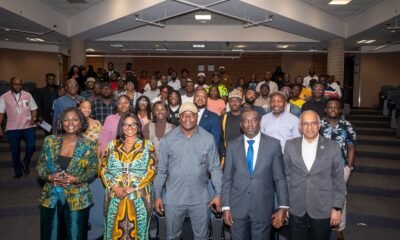News
Photo exhibition to mark World Water Day

Water is life, yet millions across Ghana, especially in the Northern Region, continue to face severe water shortages that threaten livelihoods, agriculture, and public health.
As the world observes World Water Day 2025, a resounding call for urgent action has been made – not just to raise awareness but to push for bold policies, committed action, and the use of powerful visual storytelling to drive real change.

At the World Water Day Photography Exhibition, organised by Foto4Change, leading experts, policymakers, and visual storytellers convened to emphasise the critical need for water preservation and climate resilience.
Through striking photography and immersive virtual reality (VR) experiences, the exhibition highlighted the daily struggles of communities grappling with water scarcity and the pressing need for immediate intervention.
In his opening remarks, Geoffrey Buta, Team Lead at Foto4Change, underscored the power of visual storytelling in amplifying the voices of affected communities and ensuring their struggles are seen and heard.
“Tamale has been facing water crises for almost a decade. As a visual journalist, I see it as my duty to document these issues, bring them to light, and hold those in power accountable,” Mr Buta stated.
He further urged organisations and policymakers to collaborate in tackling water challenges, emphasizing that real-life stories have the potential to inspire both public and political action.
“At Foto4Change, we have documented the struggles of mothers walking miles for water, children missing school due to unsafe drinking water, and farmers losing their crops to droughts. These stories have directly contributed to policy shifts and increased funding for water projects,” he noted.

Mad. Fauzia Aliu, Advocacy Campaigns and Inclusion Manager at WaterAid Ghana, said access to clean water is not a privilege but a fundamental human right.
Despite this, millions of Ghanaians still lack this essential resource, highlighting the urgent need for action.
Mr Sammy Adjei, Senior Project Officer – WASH/ Agric at Catholic Relief Services (CRS), shared insights on community-led water governance, which has proven successful in many regions where CRS operates.
Mr Yakubu Alhassan Kassim, WASH Officer at UNICEF’s Tamale field office, described the exhibition as a powerful advocacy tool that highlights the urgent need for water preservation and sustainable water management.
News
Swallowed by the Sea! …Keta’s coastal lines, landmarks, efforts to preserve heritage

The Atlantic Ocean is no longer a distant blue horizon for the people of Keta.
It now circles around their doorsteps, uninvited, unrelenting, pulling down walls and other structures, erasing memories, and threatening lives.
Hovering precariously between the restless sea and the Keta Lagoon, this once-thriving coastal town is slowly being obliterated.




Salt water has become both a physical and metaphorical threat, dissolving the town’s past as fast as it claims its future.
Madam Aku Atitso, 62, lives in a crumbling former Prisons Service quarters – one of the few structures still standing on the eroded stretch of Queen Street.


She sits quietly at the entrance, preparing a modest breakfast for herself and her granddaughter.
The air is thick with salt and silence. “The sea took everything,” she says softly. “My husband’s nets, our mattress, our memories all gone overnight.” Her voice trembles. “This place too is dying. But it’s the last place with a roof over my head.”
A few metres away, Aunty Esinam, 79, watches the sea from a low stool beside a wooden shelter. Her eyes do not blink. “That spot,” she points, “used to be someone’s living room, a whole family lived there”.

It’s not just homes that are vanishing. Landmarks that anchored Keta’s cultural identity are disappearing one after another. The once-imposing Fort Prinzenstein, a haunting relic of the transatlantic slave trade is now more of a ruin than a monument.

the encroaching waters along Keta’s
coast.
encroaching waters along Keta’s coast
The colonial-era Bremen factory, the old cinema where generations of children once laughed at flickering black-and-white films is also gone.
Queen Street, once the town’s bustling backbone, is now a watery corridor choked with debris.
Standing atop a section of the sea defence wall, 69-year-old retired teacher Efo Kwasi Agbeko surveys what remains.
“The first police station is mostly gone,” he says, gesturing part of the building stuck in the sea sand, only ruins and a few rooms remain.

“This town is fighting, but the sea is winning,” he said.
Even the Cape St. Paul Lighthouse, Keta’s historic sentinel, leans perilously toward the water, and fishermen say holes in the shore are opening more frequently, sometimes every week.
That leaves a thick cloud of uncertainty hanging around the historic town of Keta.
Once upon a time, it was a vibrant town noted for business but currently left with ruins with a few of the residents watching in awe the sea’s devastation.
From: Geoffrey Kwame Buta, Keta, Volta Region
News
Ghanaians climax Easter with fun-filled activities

Christians around the world and other faith based groups last Monday climaxed the Easter celebration with a number of fun-filled outdoor and indoor activities.
With streets empty, fun seekers stormed church premises where picnics were held while others partied in many ways.
Others spent the day at the various beaches and music and film shows occupying the others.

velleyball competition

at the Laboma Beach
Church in Tema Community 8 engaged
in a number of activities including the
popular draught competition
At the churches, participants engaged in bible reading, football, volleyball, playing cards, table tennis, horse racing, bouncing castles, swimming and oware.



one of the picnic venues
Others played ludo, tag of war, lime and spoon, draught, music competitions among others.
The Spectator captured some of the exciting scenes around Accra-Tema for the benefit of readers.
Story & pictures by Victor A. Buxton













